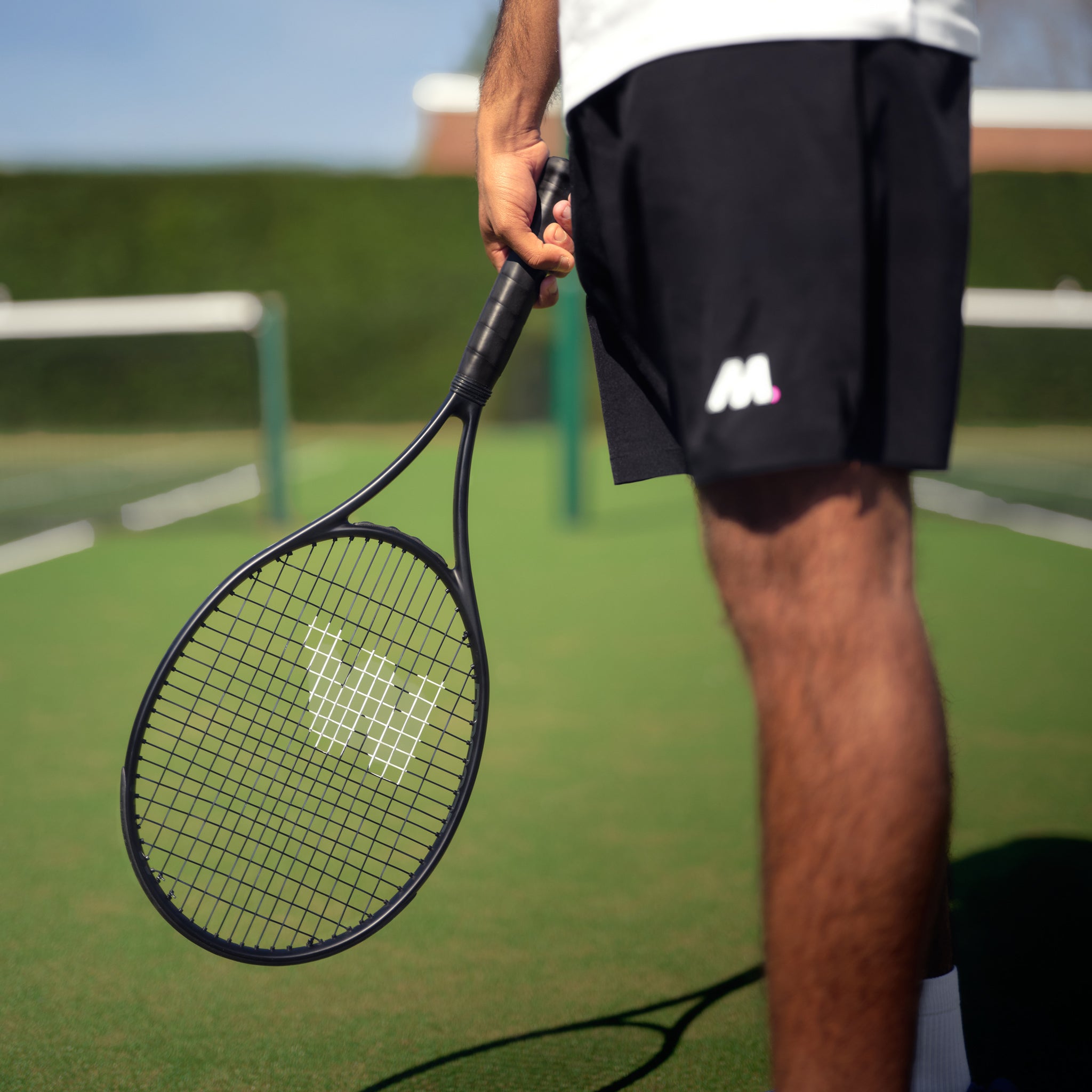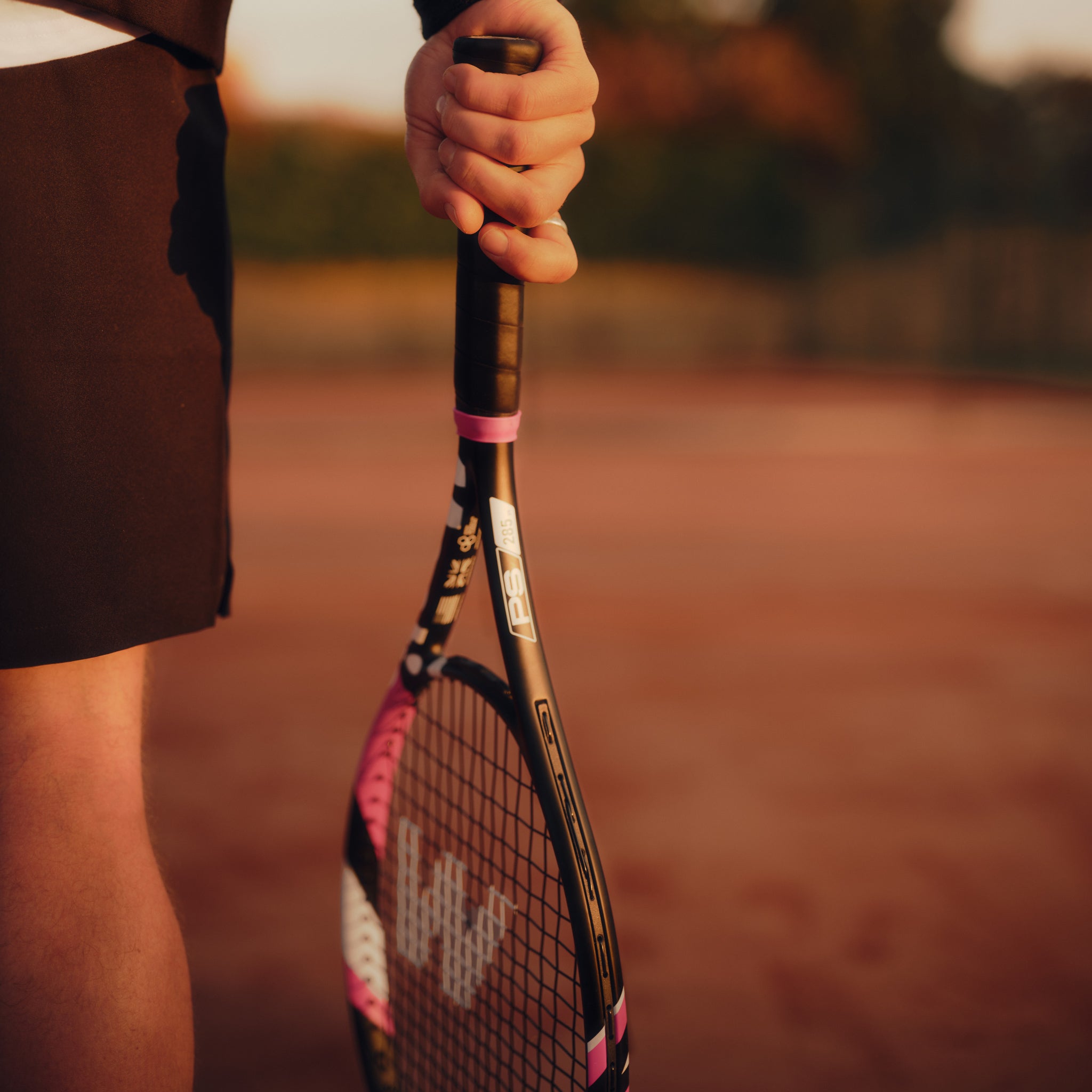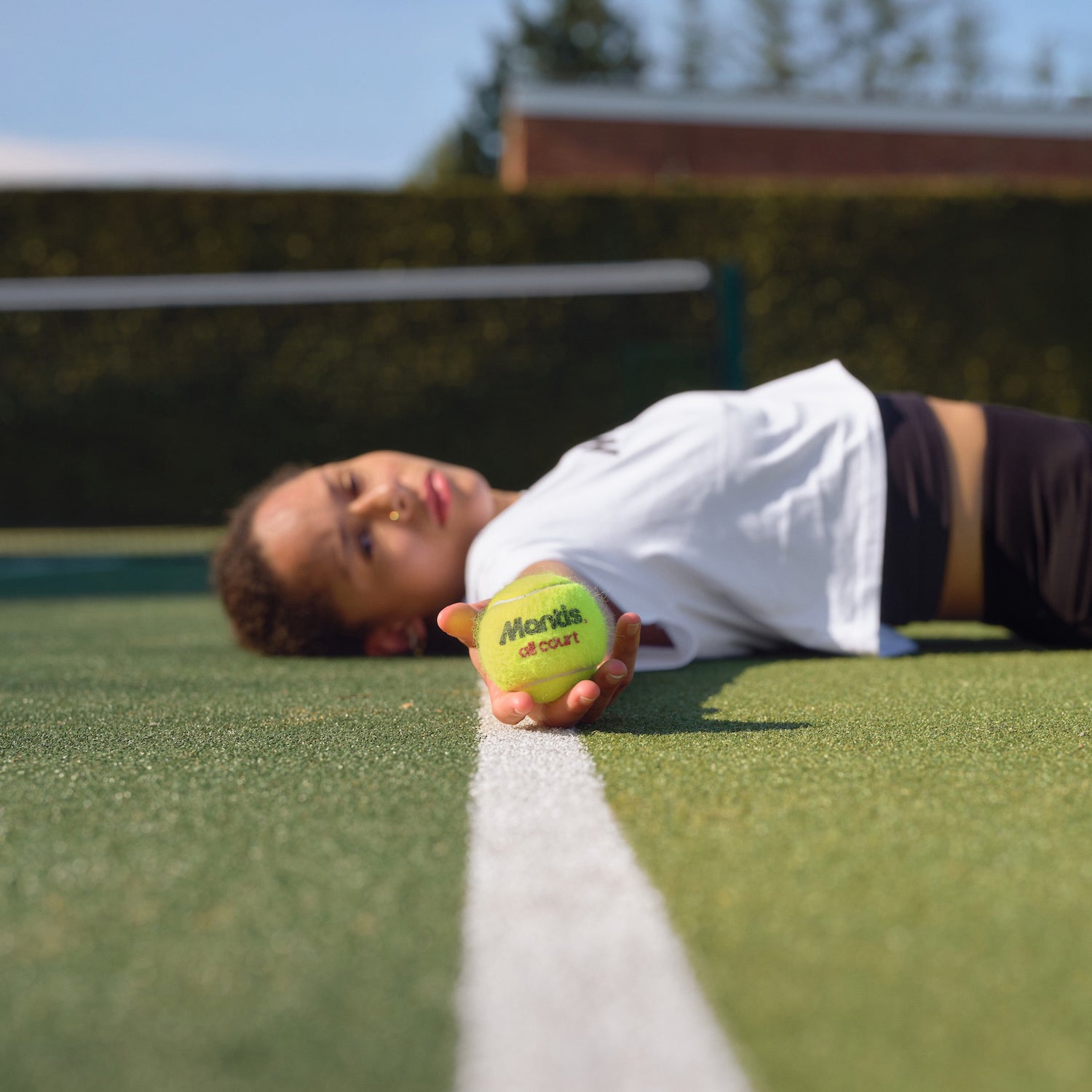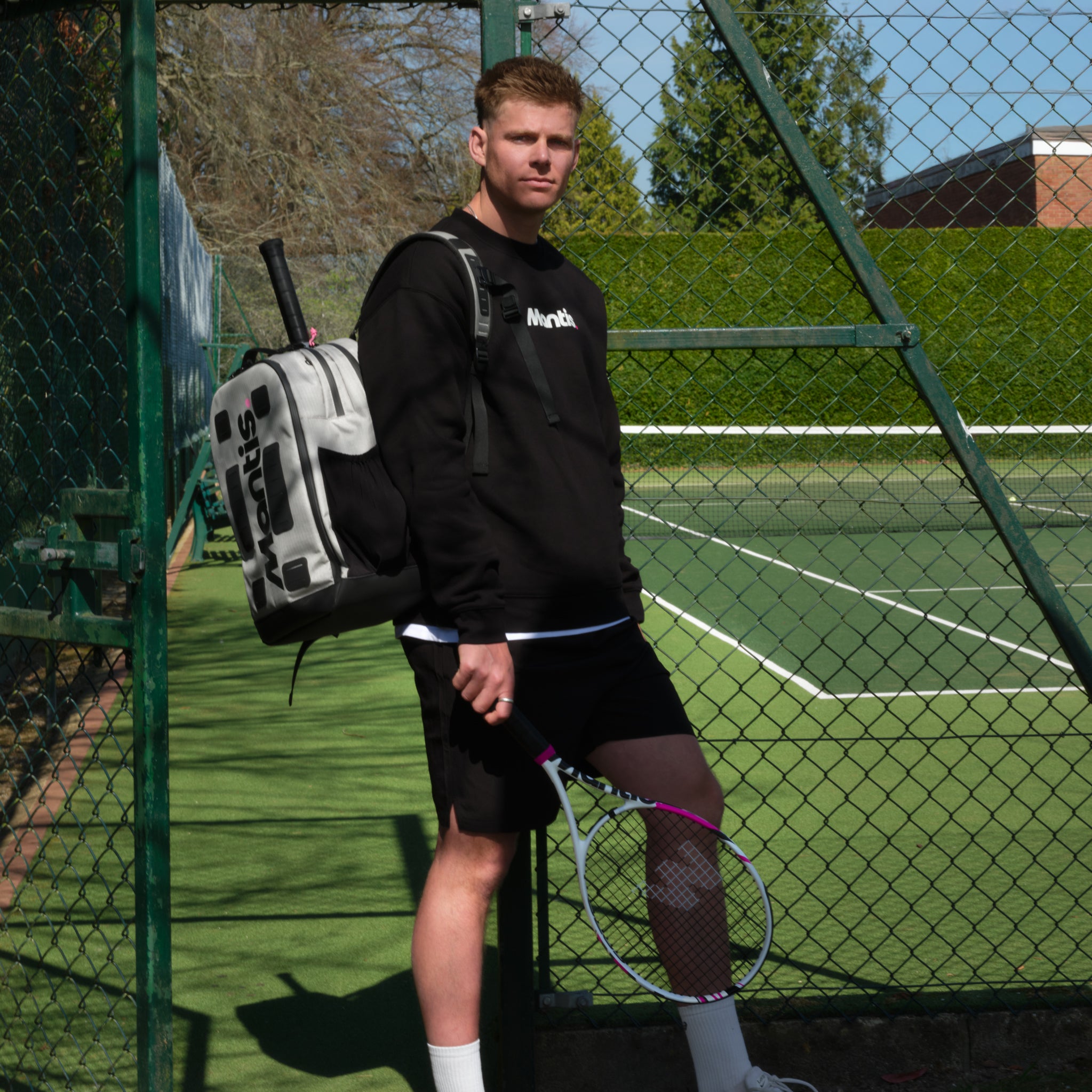
Finding the best tennis rackets for women isn't a one-size-fits-all deal. It really comes down to matching the frame's characteristics to your playing style and strength. For many women, lighter rackets with a slightly more generous head size hit a real sweet spot, offering a great mix of power, comfort, and easy handling. Here at Mantis, we believe the right racket should feel like a natural extension of your arm. That's why getting to grips with the key specifications is the first step in our guide on how to choose a tennis racket.
How to Choose The Best Tennis Rackets for Women
Picking the right tennis racket is a big decision. It can genuinely change how you play and how much you enjoy your time on the court. It’s about much more than just grabbing a popular model off the shelf; it's about finding a frame that works with your strengths and helps you improve. A well-matched racket doesn't just feel good—it builds confidence, adds a bit of pop to your shots, and gives you the control to play your game.
This guide goes deeper than simple reviews. We're going to break down the critical factors that make a racket right for you, focusing on what female players often look for. We’ll explore how things like weight, balance, stiffness, and head size all work together to shape your on-court experience. Once you understand these elements, you can make a choice that’s truly tailored to your game.
Understanding Core Racket Elements
To find your best fit, you first need to know what makes each racket different. These four pillars are what determine how a racket feels and performs when you're in the middle of a rally.
- Weight: Lighter rackets (usually under 285g) are simply easier and quicker to swing. This makes them fantastic for developing players or anyone who relies on a fast, whip-like motion.
- Balance: A head-light balance gives you more control and feel at the net, which is perfect for all-court players. On the flip side, a head-heavy balance puts more mass behind the ball, adding power for those who dominate from the baseline.
- Stiffness (RA Rating): A stiffer frame (with a higher RA rating) transfers more power to the ball but can feel a bit jarring. A more flexible frame (lower RA) is much easier on the arm and gives you a better feel for the ball.
- Head Size: A larger head size (over 100 sq. in.) offers a bigger sweet spot, which means more forgiveness on off-centre hits and a bit more power. A smaller head gives advanced players the precision they crave.
The tennis equipment market is definitely paying more attention to these details. In the United Kingdom, tennis rackets are a huge part of the industry. In fact, European data projects the tennis racket market in Europe will be worth around USD 143.558 million in 2025, with the UK making up a significant 13.32% of that. This growth shows just how much demand there is for rackets designed with the specific needs of female players in mind.
At Mantis, our goal is to cut through the jargon. We're convinced every player can find their perfect match just by understanding how these technical specs translate into actual performance on the court.
Whether you're an aggressive baseliner who loves to dictate points or a crafty all-court player who uses variety, your racket should support your identity. A power player might look for a frame that offers a bit more stability, while a touch player will want something that enhances feel and precision. Our aim is to give you the clarity you need to choose with confidence and start playing your best tennis.
Getting to Grips with Racket Specifications
Choosing a new racket can feel a bit overwhelming when you're faced with a wall of numbers and technical terms. But getting your head around these specifications is the first step to finding a frame that truly works with your game, not against it. Think of it as learning the language of your equipment. At Mantis, we want to help you make a properly informed choice. The specs are essentially the racket's DNA—they dictate its power, how much control you’ll have, and the way it feels in your hand. Even a tiny shift in one number can completely change how the racket plays. This is especially true when looking for the best women's tennis rackets, where things like comfort and easy handling often sit top of the list.
If you really want to dive deep, our complete guide to understanding tennis racket specifications breaks everything down even further.
The Balancing Act: Weight and Balance
The first things you'll probably notice are the racket's weight and balance. The static weight is straightforward—it’s just how heavy the racket is, usually measured in grams (g). Lighter rackets (under 285g) are a breeze to swing, which makes it easier to whip the racket head through the air for more pace and spin. The downside? They can sometimes feel a bit unstable when you're facing a heavy hitter.
On the other hand, heavier rackets (over 300g) feel more solid. They do a better job of absorbing and redirecting pace, but you need a bit more muscle to get them moving. It’s all about that trade-off.
- Lighter Rackets (255g - 285g): A great starting point for beginners, juniors moving up to an adult frame, or players with compact swings who need the racket to help create speed. They’re also much kinder on the arm and brilliant for quick reactions at the net.
- Heavier Rackets (285g+): Generally better for intermediate to advanced players who have full strokes and can generate their own power. You get that satisfying ‘plough-through’ and a much more solid feel at impact.
But weight is only half the story. Balance tells you where that weight is located. A racket can be head-light (more weight in the handle), head-heavy (more weight in the hoop), or evenly balanced. Head-light frames feel incredibly manoeuvrable, perfect for snappy volleys and quick adjustments. In contrast, a head-heavy racket puts more mass behind the ball, which can add some serious pop to your groundstrokes but might feel a little sluggish to swing.
It’s a common myth that light rackets are just for beginners. Many tour-level players use lighter frames that they customise with lead tape to get the exact weight and balance they want. It just goes to show that it’s the combination of all the specs that truly matters, not just one number in isolation.
Head Size and Finding the Sweet Spot
The head size, measured in square inches (sq. in.) or square centimetres (cm²), has a huge impact on the racket's power and forgiveness. A bigger head creates a larger sweet spot—that prime area on the string bed where you get the cleanest, most powerful response.
Simply put, a larger sweet spot means you don't have to be perfect. You can still hit a solid shot even if you make contact slightly off-centre.
- Oversize (105+ sq. in.): These offer the most power and a very generous hitting area. They're ideal for beginners or players with shorter, more compact swings who need the racket to lend a helping hand.
- Midplus (98-104 sq. in.): This is the sweet spot for the majority of club players. You get a fantastic blend of power, control, and forgiveness that suits a massive range of playing styles.
- Midsize (97 sq. in. and below): These are scalpels. They offer maximum control and feel but are far less forgiving. They're built for advanced players who hit the middle of the strings consistently and prioritise precision over anything else.
Ultimately, the right head size often comes down to your game style. A powerful baseliner might love the mix of pop and precision from a 100 sq. in. frame, whereas a classic serve-and-volleyer might prefer the pinpoint accuracy of a 97 sq. in. model. Nailing these fundamentals is your first step to finding a racket that feels like an extension of your arm.
Comparing Rackets for Every Player Profile
Choosing the right racket is all about matching its DNA to your on-court needs. At Mantis, we've seen time and again how the right frame can unlock a player's potential, which is why we think this process is so important. To make it easier, we can break players down into a few common profiles, each needing something a little different from their racket. Whether you're just getting the hang of things, battling it out at the club on weekends, or playing in serious tournaments, there's a racket designed to work with you, not against you. We'll go beyond just listing features and look at how specific models are built for the Beginner Improver, the Intermediate Club Player, and the Advanced Competitor. This will help you find the best tennis rackets for women by understanding how each design choice impacts your game.
The Beginner Improver Racket Profile
If you're new to the game or still working on making your strokes feel second nature, your racket should be your best friend on the court. It needs to be an ally, not a difficult piece of kit you have to fight. The main goals here are comfort, forgiveness, and getting some easy power so you can focus on your technique and build confidence.
The ideal racket for a beginner improver will almost always have:
- A larger head size: Look for something between 660-690 cm² (102-107 sq. in.). This gives you a massive sweet spot, so even if you don't hit the ball dead in the centre, you'll still get a decent shot.
- A lighter weight: A frame between 260-275g is much easier to swing. It helps you get the racket moving fast without tiring out your arm.
- A head-heavy balance: This puts more of the racket's weight in the hoop, which helps generate power and keeps the frame stable on contact, even if your swing is still developing.
The key takeaway here is simple: for an improver, the racket should do a lot of the work for you. It needs to provide easy power and a big margin for error so your technique can flourish without frustration.
The Intermediate Club Player Profile
This is where the majority of us who play regularly find ourselves. Your strokes are pretty solid, you've got a handle on tactics, and you're starting to figure out your own style—maybe you're an aggressive baseliner, a crafty all-courter, or a doubles specialist who loves the net. You need a racket that can do a bit of everything, supporting your game without any major trade-offs.
For this level, the specs start to get more balanced, offering a great mix of power and control.
- Head Size: Usually in the 630-645 cm² (98-100 sq. in.) range. This is the sweet spot for a fantastic blend of forgiveness and precision.
- Weight: An unstrung weight of 280-300g gives you enough mass to handle your opponent's pace but is still nimble enough for quick volleys at the net.
- Balance: Generally head-light or evenly balanced, which gives you better feel and faster racket-head speed for reaction shots.
Here’s a look at how racket specs tend to shift as players move up the ladder.
As you can see, as players get more advanced, the rackets tend to get heavier while the head sizes shrink. The focus moves from easy power and forgiveness towards precision and stability.
The Advanced Competitor Racket Profile
When you're playing at a competitive level, your racket stops being a tool and becomes a precision instrument. Your technique is grooved, and you create your own power. What you demand from a frame is pinpoint control, exceptional feel, and rock-solid stability when the pressure is on. These rackets are demanding, but they reward players who consistently find the middle of the strings.
An advanced player’s racket is all about control and stability:
- Head Size: Often on the smaller side, around 615-630 cm² (95-98 sq. in.), for that direct, connected-to-the-ball feel that allows for maximum precision.
- Weight: These are heavier frames, usually 305g and up. That extra mass provides fantastic plough-through and stability, helping you absorb and redirect pace with ease.
- Balance: A distinctly head-light balance is common to keep the racket manoeuvrable despite its heavier overall weight.
- Flexibility: Many advanced frames have a lower stiffness rating (RA). This allows the racket to flex more on impact, "pocketing" the ball for a split second longer to enhance feel and control.
Of course, these technological advances, like graphite composites and vibration-dampening systems, mean the average racket price has climbed. Women's performance rackets now often sit in the mid-to-high price tiers, anywhere from £80 to £250.
To help you see how some of the most popular rackets stack up against each other, we've put together a simple comparison table. This should give you a quick overview of which frames might be a good fit for your level.
Matching Racket Features to Your Playing Style
Your on-court strategy is a huge part of choosing a racket. It’s easy to get lost in all the specs, but finding the best tennis racket really comes down to how a frame’s design fits with your unique game plan. At Mantis, we’ve always believed the perfect racket should feel like a natural extension of your arm, boosting your strengths and backing up your tactics. So, how do you find that perfect match? Start by thinking about your dominant playing style. Are you a patient defender who wears opponents down? An aggressive baseliner who dictates with power? A creative all-courter who loves variety? Or maybe a net-rushing doubles specialist? Each of these styles thrives with different racket characteristics, and figuring this out is the first step to choosing with confidence.
Rackets for the Aggressive Baseliner
The aggressive baseliner is the powerhouse of the court. Your game is all about controlling points from the back with heavy, deep groundstrokes. You’re looking to push your opponent off the baseline, hit winners from deep, and command the rally with pure force.
To make this happen, you need a racket that can generate its own power and stay solid when you're trading heavy blows.
- Stiffer Frames: A higher RA rating (stiffness) means the frame bends less when you make contact, transferring more energy straight back into the ball. The result is explosive power—perfect for hitting those deep, commanding shots.
- Heavier Weight: A racket weighing 295g or more gives you that crucial plough-through. It helps you drive through the ball and stops the frame from twisting when you’re facing your opponent’s pace.
- Midplus Head Size (98-100 sq. in.): This head size hits a sweet spot between power and control, giving you the confidence to take a big swing while still aiming for the lines.
Think of a baseliner’s racket as a sledgehammer. It provides the mass and stability you need to absolutely crush the ball. The real trick is finding a frame that gives you that power without sacrificing too much control or becoming too difficult to swing.
Rackets for the Defensive Counter-Puncher
If you love long rallies and excel at outlasting your opponents, you're probably a defensive player or a counter-puncher. Your whole strategy is built around getting one more ball back, using your opponent’s pace against them, and patiently waiting for them to make a mistake or give you an opening.
For this style of play, your top priorities are control, feel, and comfort.
A defensive player’s racket should act like a precision tool. You need the feel to redirect pace effortlessly and the forgiveness to stay consistent during long, gruelling rallies. The aim is to wear down your opponent with relentless consistency.
A more flexible frame (which has a lower RA rating) is often a fantastic choice. It holds the ball on the strings for a fraction of a second longer, which really improves your feel and lets you place your shots with pinpoint accuracy. A slightly larger head size, maybe around 100-102 sq. in., offers a bigger sweet spot, which is a lifesaver for maintaining consistency when you're stretched out wide.
Rackets for the All-Court Player
The all-court player is a true tactical chameleon. You’re just as happy trading shots from the baseline as you are moving forward to finish points at the net with a sharp volley or a delicate touch shot. Your game is all about variety—you mix up spin, pace, and court position to keep your opponent completely off balance.
To support such a versatile game, your racket needs to be a real jack-of-all-trades.
- Balanced Specifications: Look for a frame that doesn’t lean too far in one direction. A moderate weight (around 285-300g) combined with a head-light balance is often the ideal setup.
- Manoeuvrability: That head-light balance makes the racket so much easier to get into position at the net, giving you the quick reactions you need for precise volleying.
- Good Feel: A frame that gives you clear feedback is absolutely essential for hitting those tricky drop shots and angled volleys with confidence.
For an all-court strategist, the racket has to do it all. It needs to be stable enough for a heavy topspin forehand from the baseline and, on the very next ball, nimble enough for a soft touch volley at the net. It's all about finding that perfect middle ground that supports every shot in your arsenal.
Rackets for the Doubles Specialist
Doubles is a completely different beast. It demands lightning-fast reflexes, sharp angles, and total domination at the net. As a doubles player, your game likely revolves around serve-and-volley tactics, picking off shots, and ending points as quickly as possible.
Your racket needs to be fast and forgiving. A head-light balance is non-negotiable; it’s what allows you to make rapid adjustments during those quick-fire exchanges at the net. A lighter overall weight (often between 270-290g) also helps with that swift manoeuvrability. Many doubles players also benefit from an oversize or generous midplus head size, which gives you a larger hitting area for blocking back powerful serves and hitting tough reaction volleys.
By taking an honest look at your playing style, you can cut through the noise of the massive racket market and focus on frames that are actually built to complement your strengths. This approach ensures your new racket won’t just feel good in your hand—it will actively help you play better tennis.
Grip Size and Customisation: The Overlooked Details
The handle is your only connection to the racket, yet its grip size is something players often completely ignore when looking for a new frame. At Mantis, we see this as a huge mistake. Getting the size right is absolutely fundamental for comfort, control, and—crucially—for preventing injuries like tennis elbow. When a grip fits properly, your hand and forearm can stay relaxed, which allows for smooth, powerful strokes. But if the grip is wrong, you’re forced to clench your muscles just to stop the racket from twisting in your hand. This leads to fatigue, kills your technique, and can be the simple reason a confident shot turns into a frustrating mishit.
Finding Your Perfect Grip Size
Figuring out your grip size is surprisingly simple. One of the easiest and most reliable ways is the old-school ruler test. Just open your playing hand, keep your fingers together, and measure from the main crease at the bottom of your palm up to the tip of your ring finger.
Whatever that measurement is in inches, that’s your grip size. So, if you measure 4 3/8 inches, you’re a size 3 (often labelled L3).
Here’s a quick guide to common sizes:
- Size 0 (4 inches): Generally best for juniors.
- Size 1 (4 1/8 inches): A popular choice for women with smaller hands.
- Size 2 (4 1/4 inches): This is the most common grip size for female players.
- Size 3 (4 3/8 inches): A good fit for women with larger hands or anyone who just prefers a chunkier feel.
A good rule of thumb: if you’re ever stuck between two sizes, go for the smaller one. You can always build up a grip with an overgrip, but you can’t shrink a handle that’s too big.
The industry is finally catching on to the need for better-fitting gear. In 2024, we saw a 24% year-over-year rise in global sales for women-specific tennis rackets. This surge shows a clear demand for frames designed with lighter weights and smaller grip sizes tailored for female players. Here in the UK, these rackets are becoming the go-to choice for club players. If you want to dig deeper into these trends, the latest tennis equipment market research from Future Market Insights offers a great overview.
The Art of Racket Customisation
Getting the grip size spot on is your starting point, but the real magic happens with customisation. This is how you take a great racket and make it your racket, perfectly dialled in for your game. Your two main tools here are overgrips and strings.
An overgrip is simply a thin wrap that goes over the original grip. It does two key things: it adds a tiny bit to the handle’s circumference and gives you a specific feel.
Think of an overgrip as the final touch that dials in your connection to the racket. It can transform a standard handle into one that feels custom-made for your hand, enhancing both comfort and confidence on every shot.
You’ve got a few different types to choose from:
- Tacky Overgrips: These have a sticky feel that gives you a really secure hold, so the racket won’t slip during a tough rally.
- Dry Overgrips: Perfect for players whose hands sweat a lot. They soak up moisture to help you maintain a firm grasp.
- Cushioned Overgrips: These add a bit of extra padding to absorb vibrations and make for a more comfortable hit.
Beyond the handle, your choice of strings and tension can completely change how a racket plays. Stringing at a lower tension gives you more power and a more forgiving sweet spot. On the other hand, a higher tension offers more control, which is great for players who already generate plenty of their own pace. At Mantis, we believe customisation is that final, essential step that turns a fantastic frame into your ultimate weapon on the court. The other option is to consult with an expert such as a coach to help with your own racket customisation.
Common Questions About Women's Tennis Rackets
Even with all the specs and play styles laid out, a few questions always seem to come up just when you're about to make a final decision. At Mantis, we know that confidence on the court starts with confidence in your equipment. That’s why we’ve gathered some of the most frequent queries we hear, offering clear, straightforward advice to help you invest in your game wisely. If you want a complete overview, it's well worth looking at our broader guide on how to choose a tennis racket. For now, let’s tackle those specific questions that might still be on your mind.
What Is the Most Important Factor for a Female Beginner?
Without a doubt, the single most important factor is forgiveness. When you're just starting out, your main focus is on developing your technique, and the last thing you need is a difficult racket causing frustration. Forgiveness really comes from two key things: a larger head size (102 sq. in. or more) and a lighter static weight (somewhere around 260-275g).
A generous head size gives you a bigger sweet spot, which means you don’t have to strike the ball perfectly in the centre every time to get a good shot over the net. This is a huge confidence booster and makes learning the game so much more enjoyable. A lighter frame is also much easier to swing, which helps you generate racket-head speed without putting stress on your arm—crucial for preventing injury and grooving smooth, fluid strokes.
How Do I Know When It Is Time to Replace My Racket?
Realising your racket is holding you back is a key part of improving your game. There are a few tell-tale signs that it might be time for an upgrade.
- You've outgrown it: If you started with a beginner-friendly racket but your skills have jumped a level or two, you might feel a lack of control or stability. Shots that used to feel great might start sailing long, which is often a sign you need a more control-focused frame.
- Physical damage: Give your frame a close inspection. Look for any cracks, especially around the grommets or the throat of the racket. Even a tiny hairline fracture can compromise performance and isn't safe to play with. A dead giveaway is often a strange buzzing sound or an odd vibration on impact.
- Constant restringing: Does your racket feel "dead" or lifeless? If you find yourself restringing it more and more often just to get some pop back in your shots, the frame itself may have lost its responsiveness. The graphite fibres break down after thousands of hits, leading to a noticeable drop in power and feel.
As a rule of thumb, a dedicated club player should think about replacing their racket every two to three years. A frame can certainly last longer, but its performance characteristics will slowly degrade, and you might not even realise how much it's subtly affecting your game.
Does a More Expensive Racket Guarantee I Will Play Better?
That’s one of the biggest myths in tennis. A hefty price tag does not automatically mean better performance on the court. In reality, high-end rackets are built for advanced players who have fully developed strokes and can generate their own power. These frames tend to be heavier, less forgiving, and have smaller head sizes, demanding a level of precision that a beginner or intermediate player simply doesn't have yet.
Trying to play with a racket that’s too advanced for your level can actually do more harm than good. It will likely feel unwieldy, lead to arm fatigue, and make controlling your shots a real battle. The "best" racket is always the one that suits your specific skill level, playing style, and physical strength—not the one with the biggest price.
Your focus should be on finding a frame that complements your game as it is right now, giving you the confidence to improve. The right racket makes tennis more fun and helps you develop your skills properly, which is a much smarter investment than just grabbing the most expensive model off the shelf.
At Mantis, we believe that precision and performance should be accessible to every dedicated player. Explore our range of expertly crafted rackets, strings, and accessories designed for those who live for the game. Find your perfect match at https://mantissport.com.








